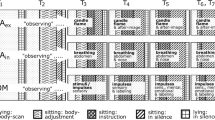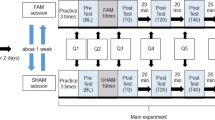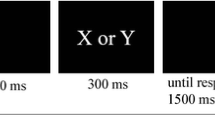Abstract
Focused attention (FAM) and open monitoring (OMM) meditation types establish distinct metacontrol states that have immediate effects on how attention allocation strategies are utilised in subsequent, unrelated tasks. Because attention allocation is a central factor in sequential action, the present experiment investigated whether a single-session of FAM and OMM enhanced subsequent sequence performance and learning. Relative to a control listening task, a single session of FAM or OMM resulted in heightened sequence performance without affecting sequence learning on average. However, the level of effort experienced in the meditation conditions was found to significantly correlate with sequence learning indices and post hoc analyses revealed that low effort level in both meditation groups was associated with significantly greater general sequence performance improvements. Interestingly, the degree of sequence-specific learning that brought about these improvements was enhanced only by OMM and only in those reporting low effort level with this meditation type. Thus, only the combination of low effort and OMM established a cognitive control state that was beneficial for the acquisition of complex sequence structures. This work provides further insights into instantaneous effects of FAM and OMM on goal-oriented cognitive function while also raising important questions about the control of mediation-induced states.





Similar content being viewed by others
References
Abrahamse, E. L., & Noordzij, M. L. (2011). Designing training programs for perceptual-motor skills: practical implications from the serial reaction time task. European Review of Applied Psychology-Revue Europeenne De Psychologie Appliquee, 61(2), 65–76. doi:10.1016/j.erap.2010.12.001.
Abrahamse, E. L., & Verwey, W. B. (2008). Context dependent learning in the serial RT task. Psychological Research-Psychologische Forschung, 72(4), 397–404. doi:10.1007/s00426-007-0123-5.
Abrahamse, E. L., Jiménez, L., Verwey, W. B., & Clegg, B. A. (2010). Representing serial action and perception. Psychonomic Bulletin & Review, 17(5), 603–623. doi:10.3758/pbr.17.5.603.
Abrahamse, E. L., Ruitenberg, M. F. L., de Kleine, E., & Verwey, W. B. (2013). Control of automated behavior: insights from the discrete sequence production task. Frontiers in Human Neuroscience, 7. doi: 10.3389/fnhum.2013.00082
Ainsworth, B., Eddershaw, R., Meron, D., Baldwin, D. S., & Garner, M. (2013). The effect of focused attention and open monitoring meditation on attention network function in healthy volunteers. Psychiatry Research, 210(3), 1226–1231. doi:10.1016/j.psychres.2013.09.002.
Amer, T., Campbell, K. L., & Hasher, L. (2016). Cognitive control as a double-edged sword. Trends in Cognitive Sciences, 20(12), 905–915.
Baas, M., Nevicka, B., & Ten Velden, F. S. (2014). Specific mindfulness skills differentially predict creative performance. Personality and Social Psychology Bulletin, 40(9), 1092–1106. doi:10.1177/0146167214535813.
Baumeister, R. F., Heatherton, T. F., & Tice, D. M. (1994). Losing control: how and why people fail at self-regulation. San Diego, CA: Academic Press.
Baumeister, R. F., Vohs, K. D., & Tice, D. M. (2007). The strength model of self-control. Current Directions in Psychological Science, 16(6), 351–355.
Borragan, G., Slama, H., Destrebecqz, A., & Peigneux, P. (2016). Cognitive fatigue facilitates procedural sequence learning. Frontiers in Human Neuroscience, 10. doi: 10.3389/fnhum.2016.00086
Brashers-Krug, T., Shadmehr, R., & Bizzi, E. (1996). Consolidation in human motor memory. Nature, 382(6588), 252–255. doi:10.1038/382252a0.
Brefczynski-Lewis, J. A., Lutz, A., Schaefer, H. S., Levinson, D. B., & Davidson, R. J. (2007). Neural correlates of attentional expertise in long-term meditation practitioners. Proceedings of the National Academy of Sciences of the United States of America, 104(27), 11483–11488. doi:10.1073/pnas.0606552104.
Carter, O. L., Presti, D. E., Callistemon, C., Ungerer, Y., Liu, G. B., & Pettigrew, J. D. (2005). Meditation alters perceptual rivalry in Tibetan Buddhist monks. Current Biology, 15(11), R412–R413. doi:10.1016/j.cub.2005.05.043.
Chan, R. W., Immink, M. A., Lushington, K., & Mosewich, A. D. (2016). Stimulus or response based sequence learning is determined by temporal placement of a preceding focused attention meditation. Journal of Sport & Exercise Psychology, 38(S), S52.
Clegg, B. A., DiGirolamo, G. J., & Keele, S. W. (1998). Sequence learning. Trends in Cognitive Sciences, 2(8), 275–281. doi:10.1016/S1364-6613(98)01202-9.
Colzato, L. S., Ozturk, A., & Hommel, B. (2012). Meditate to create: the impact of focused-attention and open-monitoring training on convergent and divergent thinking. Frontiers in Psychology, 3. doi: 10.3389/fpsyg.2012.00116
Colzato, L. S., Szapora, A., Lippelt, D. P., & Hommel, B. (2014). Prior meditation practice modulates performance and strategy use in convergent- and divergent-thinking problems. Mindfulness, 1–7. doi:10.1007/s12671-014-0352-9.
Colzato, L. S., Sellaro, R., Samara, I., Baas, M., & Hommel, B. (2015a). Meditation-induced states predict attentional control over time. Consciousness and Cognition, 37, 57–62. doi:10.1016/j.concog.2015.08.006.
Colzato, L. S., Sellaro, R., Samara, I., & Hommel, B. (2015b). Meditation-induced cognitive-control states regulate response-conflict adaptation: evidence from trial-to-trial adjustments in the Simon task. Consciousness and Cognition, 35, 110–114. doi:10.1016/j.concog.2015.04.012.
Colzato, L. S., van der Wel, P., Sellaro, R., & Hommel, B. (2016). A single bout of meditation biases cognitive control but not attentional focusing: evidence from the global-local task. Consciousness and Cognition, 39, 1–7. doi:10.1016/j.concog.2015.11.003.
Daltrozzo, J., & Conway, C. M. (2014). Neurocognitive mechanisms of statistical-sequential learning: what do event-related potentials tell us? Frontiers in Human Neuroscience, 8. doi: 10.3389/fnhum.2014.00437
Delevoye-Turrell, Y. N., & Bobineau, C. (2012). Motor consciousness during intention-based and stimulus-based actions: modulating attention resources through mindfulness meditation. Frontiers in Psychology, 3. doi: 10.3389/fpsyg.2012.00290
Elsner, B., & Hommel, B. (2001). Effect anticipation and action control. Journal of Experimental Psychology-Human Perception and Performance, 27(1), 229–240. doi:10.1037/0096-1523.27.1.229.
Finn, A. S., Lee, T., Kraus, A., & Kam, C. L. H. (2014). When it hurts (and helps) to try: the role of effort in language learning. PloS One, 9(7). doi:10.1371/journal.pone.0101806.
Foerde, K., Knowlton, B. J., & Poldrack, R. A. (2006). Modulation of competing memory systems by distraction. Proceedings of the National Academy of Sciences of the United States of America, 103(31), 11778–11783. doi:10.1073/pnas.0602659103.
Galea, J. M., Albert, N. B., Ditye, T., & Miall, R. C. (2010). Disruption of the dorsolateral prefrontal cortex facilitates the consolidation of procedural skills. Journal of Cognitive Neuroscience, 22(6), 1158–1164. doi:10.1162/jocn.2009.21259.
Gallant, S. N. (2016). Mindfulness meditation practice and executive functioning: breaking down the benefit. Consciousness and Cognition, 40, 116–130. doi:10.1016/j.concog.2016.01.005.
Gard, T., Holzel, B. K., & Lazar, S. W. (2014). The potential effects of meditation on age-related cognitive decline: a systematic review. Advances in Meditation Research: Neuroscience and Clinical Applications, 1307, 89–103. doi:10.1111/nyas.12348.
Green, S. B., & Salkind, N. J. (2005). Using SPSS for Windows and Macintosh: analyzing and understanding data (4th ed.). Upper Saddle River, NJ: Pearson Prentice Hall.
Hasenkamp, W., Wilson-Mendenhall, C. D., Duncan, E., & Barsalou, L. W. (2012). Mind wandering and attention during focused meditation: a fine-grained temporal analysis of fluctuating cognitive states. NeuroImage, 59(1), 750–760. doi:10.1016/j.neuroimage.2011.07.008.
Hockey, G. R. J. (2011). A motivational control theory of cognitive fatigue. In P. L. Ackerman (Ed.), Cognitive fatigue: multidisciplinary perspectives on current research and future applications (pp. 167–188). Washington, DC: American Psychological Association.
Hodgins, H. S., & Adair, K. C. (2010). Attentional processes and meditation. Consciousness and Cognition, 19(4), 872–878. doi:10.1016/j.concog.2010.04.002.
Holland, P. C. (2008). Cognitive versus stimulus-response theories of learning. Learning & Behavior, 36(3), 227–241. doi:10.3758/Lb.36.3.227.
Holzel, B. K., Lazar, S. W., Gard, T., Schuman-Olivier, Z., Vago, D. R., & Ott, U. (2011). How does mindfulness meditation work? Proposing mechanisms of action from a conceptual and neural perspective. Perspectives on Psychological Science, 6(6), 537–559. doi:10.1177/1745691611419671.
Hommel, B. (1996). The cognitive representation of action: automatic integration of perceived action effects. Psychological Research-Psychologische Forschung, 59(3), 176–186. doi:10.1007/Bf00425832.
Hommel, B. (2000). The prepared reflex: automaticity and control in stimulus-response translation. In M. S. & D. J. (Ed.), Control of cognitive processes: attention and performance (pp. 247–273). Cambridge, MA: MIT Press.
Hommel, B. (2015). Between persistence and flexibility: the Yin and Yang of action control. Advances in Motivation Science, 2, 33–67.
Immink, M. A. (2016). Post-training meditation promotes motor memory consolidation. Frontiers in Psychology, 7. doi: 10.3389/fpsyg.2016.01698
Keele, S. W., Ivry, R., Mayr, U., Hazeltine, E., & Heuer, H. (2003). The cognitive and neural architecture of sequence representation. Psychological Review, 110(2), 316–339. doi:10.1037/0033-295x.110.2.316.
Kiesel, A., & Hoffmann, J. (2004). Variable action effects: response control by context-specific effect anticipations. Psychological Research-Psychologische Forschung, 68(2–3), 155–162. doi:10.1007/s00426-003-0152-7.
Lippelt, D. P., Hommel, B., & Colzato, L. S. (2014). Focused attention, open monitoring and loving kindness meditation: effects on attention, conflict monitoring, and creativity—a review. Frontiers in Psychology, 5. doi: 10.3389/fpsyg.2014.01083
Lumma, A. L., Kok, B. E., & Singer, T. (2015). Is meditation always relaxing? Investigating heart rate, heart rate variability, experienced effort and likeability during training of three types of meditation. International Journal of Psychophysiology, 97(1), 38–45. doi:10.1016/j.ijpsycho.2015.04.017.
Lutz, A., Slagter, H. A., Dunne, J. D., & Davidson, R. J. (2008). Attention regulation and monitoring in meditation. Trends in Cognitive Sciences, 12(4), 163–169. doi:10.1016/j.tics.2008.01.005.
Malinowski, P. (2013). Neural mechanisms of attentional control in mindfulness meditation. Frontiers in Neuroscience, 7. doi: 10.3389/fnins.2013.00008
Manna, A., Raffone, A., Perrucci, M. G., Nardo, D., Ferretti, A., Tartaro, A., et al. (2010). Neural correlates of focused attention and cognitive monitoring in meditation. Brain Research Bulletin, 82(1–2), 46–56. doi:10.1016/j.brainresbull.2010.03.001.
Meiran, N., Hommel, B., Bibi, U., & Lev, I. (2002). Consciousness and control in task switching. Consciousness and Cognition, 11(1), 10–33. doi:10.1006/ecog.2001.0521.
Miyake, A., Friedman, N. P., Emerson, M. J., Witzki, A. H., Howerter, A., & Wager, T. D. (2000). The unity and diversity of executive functions and their contributions to complex “frontal lobe” tasks: a latent variable analysis. Cognitive Psychology, 41(1), 49–100. doi:10.1006/cogp.1999.0734.
Moore, A., & Malinowski, P. (2009). Meditation, mindfulness and cognitive flexibility. Consciousness and Cognition, 18(1), 176–186. doi:10.1016/j.concog.2008.12.008.
Moore, A., Gruber, T., Derose, J., & Malinowski, P. (2012). Regular, brief mindfulness meditation practice improves electrophysiological markers of attentional control. Frontiers in Human Neuroscience, 6. doi: 10.3389/fnhum.2012.00018
Nissen, M. J., & Bullemer, P. (1987). Attentional requirements of learning—evidence from performance-measures. Cognitive Psychology, 19(1), 1–32. doi:10.1016/0010-0285(87)90002-8.
Reed, J., & Johnson, P. (1994). Assessing implicit learning with indirect tests—determining what is learned about sequence structure. Journal of Experimental Psychology-Learning Memory and Cognition, 20(3), 585–594. doi:10.1037//0278-7393.20.3.585.
Robertson, E. M. (2007). The serial reaction time task: implicit motor skill learning? Journal of Neuroscience, 27(38), 10073–10075. doi:10.1523/Jneurosci.2747-07.2007.
Sakai, K., Kitaguchi, K., & Hikosaka, O. (2003). Chunking during human visuomotor sequence learning. Experimental Brain Research, 152(2), 229–242. doi:10.1007/s00221-003-1548-8.
Sakai, K., Hikosaka, O., & Nakamura, K. (2004). Emergence of rhythm during motor learning. Trends in Cognitive Sciences, 8(12), 547–553. doi:10.1016/j.tics.2004.10.005.
Schneider, W., & Shiffrin, R. M. (1977). Controlled and automatic human information-processing.1. Detection, search, and attention. Psychological Review, 84(1), 1–66. doi:10.1037/0033-295x.84.1.1.
Schwarb, H., & Schumacher, E. H. (2012). Generalized lessons about sequence learning from the study of the serial reaction time task. Advances in Cognitive Psychology, 8(2), 165–178. doi:10.5709/acp-0113-1.
Slagter, H. A., Lutz, A., Greischar, L. L., Francis, A. D., Nieuwenhuis, S., Davis, J. M., & Davidson, R. J. (2007). Mental training affects distribution of limited brain resources. PLoS Biology, 5(6), 1228–1235. doi:10.1371/journal.pbio.0050138.
Stroop, J. R. (1992). Studies of interference in serial verbal reactions (Reprinted from Journal Experimental-Psychology, Vol 18, Pg 643–662, 1935). Journal of Experimental Psychology-General, 121(1), 15–23. Retrieved from <Go to ISI>://WOS:A1992HE76400004
Tang, Y. Y., Ma, Y., Wang, J., Fan, Y., Feng, S., Lu, Q., et al. (2007). Short-term meditation training improves attention and self-regulation. Proceedings of the National Academy of Sciences, 104(43), 17152–17156. doi:10.1073/pnas.0707678104.
Tang, Y. Y., Holzel, B. K., & Posner, M. I. (2015). The neuroscience of mindfulness meditation. Nature Reviews Neuroscience, 16(4), 213–U280. doi:10.1038/nrn3916.
Tops, M., Boksem, M. A. S., Quirin, M., IJzerman, H., & Koole, S. L. (2014). Internally directed cognition and mindfulness: an integrative perspective derived from predictive and reactive control systems theory. Frontiers in Psychology, 5. doi: 10.3389/fpsyg.2014.00429
Tubau, E., Hommel, B., & Lopez-Moliner, J. (2007). Modes of executive control in sequence learning: from stimulus-based to plan-based control. Journal of Experimental Psychology-General, 136(1), 43–63. doi:10.1037/0096-3445.136.1.43.
Vago, D. R., & Silbersweig, D. A. (2012). Self-awareness, self-regulation, and self-transcendence (S-ART): a framework for understanding the neurobiological mechanisms of mindfulness. Frontiers in Human Neuroscience, 6. doi: 10.3389/fnhum.2012.00296
Valentine, E. R., & Sweet, P. L. (1999). Meditation and attention: a comparison of the effects of concentrative and mindfulness meditation on sustained attention. Mental Health, Religion & Culture, 2(1), 59–70.
van den Hurk, P. A. M., Giommi, F., Gielen, S. C., Speckens, A. E. M., & Barendregt, H. P. (2010). Greater efficiency in attentional processing related to mindfulness meditation. Quarterly Journal of Experimental Psychology, 63(6), 1168–1180. doi:10.1080/17470210903249365.
van Leeuwen, S., Singer, W., & Melloni, L. (2012). Meditation increases the depth of information processing and improves the allocation of attention in space. Frontiers in Human Neuroscience, 6. doi: 10.3389/fnhum.2012.00133
Veale, J. F. (2014). Edinburgh handedness inventory—short form: a revised version based on confirmatory factor analysis. Laterality, 19(2), 164–177. doi:10.1080/1357650x.2013.783045.
Willingham, D. B. (1999). Implicit motor sequence learning is not purely perceptual. Memory & Cognition, 27(3), 561–572. doi:10.3758/Bf03211549.
Zeidan, F., Johnson, S. K., Diamond, B. J., David, Z., & Goolkasian, P. (2010). Mindfulness meditation improves cognition: evidence of brief mental training. Consciousness and Cognition, 19(2), 597–605. doi:10.1016/j.concog.2010.03.014.
Author information
Authors and Affiliations
Corresponding author
Rights and permissions
About this article
Cite this article
Immink, M.A., Colzato, L.S., Stolte, M. et al. Sequence Learning Enhancement Following Single-Session Meditation Is Dependent on Metacontrol Mode and Experienced Effort. J Cogn Enhanc 1, 127–140 (2017). https://doi.org/10.1007/s41465-017-0019-2
Received:
Accepted:
Published:
Issue Date:
DOI: https://doi.org/10.1007/s41465-017-0019-2




